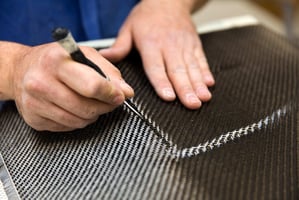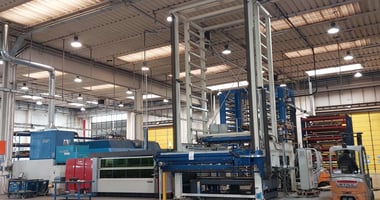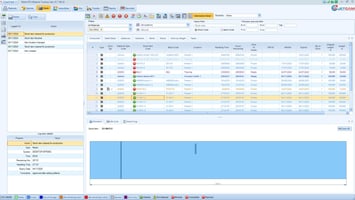A Challenge in Location, Life, and Consumption Tracking Pre-preg composite materials offer...
Integrating with and automating Freezer and Raw Material Management Systems
Efficiency and traceability have continuously been core tenets in automated manufacturing, forcing factories to look at new opportunities for optimisation. In the composite manufacturing industry, each manufacturing department is looking for innovative solutions which, when looked at as part of a bigger picture, can deliver benefits on a much larger scale. In this article we explore the benefits of incorporating CrossTrack composite manufacturing software into automated freezer and raw material management systems, resulting in significant benefits, improvements, and savings.

CrossTrack functions as a conduit between your ERP/MES system and JETCAM Expert nesting software, offering distinctive control over material location, life, and consumption, as well as automating the nest creation process. This integration ensures absolute material traceability - an indispensable requirement in modern composite manufacturing ecosystems.
Let's explore the advantages that come by incorporating CrossTrack into a manufacturing operation.
Management of Material Location and Consumption
Maintaining precise track of material location and consumption is a challenging task in composite manufacturing industries, particularly those storing materials in automated freezers. CrossTrack unearths a comprehensive approach, enabling accurate tracking of materials, right from supplier delivery to part production.
The ability for CrossTrack to streamline material utilisation can result in significant cost savings. It reduces the risk of material expiry and minimises waste by alerting operatives to material location, remaining life, and allocation. Moreover, CrossTrack can prevent material overstocking - a pivotal step in effective inventory management, contributing to overall operational savings.
End-to-End Material Traceability
In the composite world, traceability is not merely a regulatory requirement but is required in the event of part failure. CrossTrack offers this peace of mind. It helps track and manage not only the location and life-history of materials but contributes to the production workflow, adding an extra layer of transparency to the entire process while reducing or removing additional stages that are often performed with manual input.
Integration with Existing Systems
Seamless integration of CrossTrack with existing ERP/MES systems and JETCAM Expert nesting software streamlines the workflow of manufacturing processes, yet still allows for flexibility to deal with 'real world' situations, such as being able to re-life or modify material dimensions - all while maintaining a traceability log of these actions. This integration offers a great deal of flexibility, allowing for consistency in business processes and a seamless, system-wide flow of information - 'one place of truth within the business'.
So, how can we integrate with such systems and what data needs to be exchanged? The 'how' can be as simple as generating a CSV text file, although you then have to consider the method of exchanging this file e.g., will it be manually export/import, or can the process be automated by one system auto-generating the file and another scanning a folder for its arrival. This method works well for many, but is not as 'bullet proof' as fully automated EDI (electronic data exchange).
A more common and robust method would be using web services. This allows data exchange to occur in real time without any user interaction. CrossTrack's 'alerts and triggers' functionality allows users to specify that when a particular event occurs, such as the operator transferring material or a nest being cut, that the appropriate web service is called and the data is passed accordingly. This can work both ways - external systems can place 'web hooks', passing information to CrossTrack when an event occurs.
Examples of integration:
- Automated Freezer: Operators at the freezer can request for a roll to be retrieved. At the same time, the automated freezer will use web services to update the location of the material item or kit to a 'defrost' area. This removes the need for the operator to manually scan an item to update its location, and also ensure that accurate defrost times are maintained
- Roll management at the cutter: Rolls can be loaded into a roll management system at the cutter, which in CrossTrack can be its own location. When an operator is ready to start a job an instruction can be sent via web services to load the relevant roll onto the cutter, also changing its location. This transaction would also be logged, removes the need for the operator to log in, and provides a further level of depth for traceability.
- Autoclave: CrossTrack can be configured to stop counting material shop life once an item either scanned at arriving at a given location or an operation is marked as complete. If an autoclave is able to pass back data to other systems, such as ERP, then adding a call to CrossTrack to report a location change will also 'stop the clock' ticking down on the life of the composite part automatically. Again, this reduces the time required by staff and the possibility of error, plus gives more accurate manufacturing runtime data, which in turn can filter down to quote accuracy.
Data Utilisation and Decision Making
This wealth of additional data at your fingertips can aid in identifying areas of improvement, facilitating strategic decision-making, and harnessing predictive analysis. That ultimately leads to process optimisations that can result in substantial progress in productivity and cost-effectiveness.
Integrating CrossTrack software into your automated freezer and raw material management systems can deliver greater control and efficiency. By streamlining material management, providing full traceability, facilitating integration, and enabling enhanced decision-making, CrossTrack positions itself as a powerful tool for savings and improvements in composite manufacturing contexts.
%20(Custom).jpg?width=1000&height=252&name=JETCAM%20logo%20(glossy%20effect)%20(Custom).jpg)


